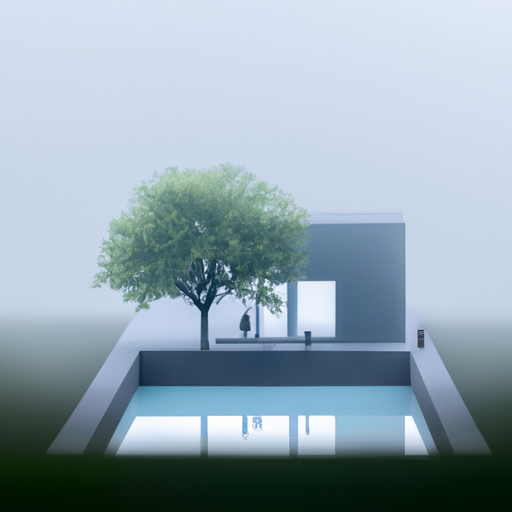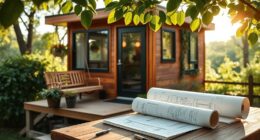In a time when housing prices continue to skyrocket, tiny houses are now seen as a practical and environmentally friendly alternative. Nikki, a teacher, has embraced this simple way of living by transitioning to a custom-built, 43-foot mobile home in Austin, Texas. With her three dogs by her side, Nikki’s creatively designed living space prioritizes privacy and a sense of openness. This decision allows her to significantly reduce her monthly costs and focus on paying off debt.
Working with NOMAD Tiny Homes, Nikki’s custom design could easily be used as a three-bedroom home for a family. Her ultimate goal is to buy land and provide affordable living spaces for other educators who face similar financial and housing struggles.
Nikki’s story is a testament to the growing appeal of tiny homes and how they can provide a practical solution for those seeking affordable living options. In this article, we will explore the layout of Nikki’s tiny home, her future plans, and the benefits of tiny house living.
Key Takeaways
- Educator Nikki downsized to a 43-foot custom-built tiny house on wheels in Austin, Texas to save money and pay off debt.
- The unique layout of Nikki’s tiny house offers maximum privacy and spaciousness, and could easily be used as a three-bedroom home for a family.
- Tiny homes require significantly less energy and resources to build and maintain, making them a more sustainable housing option.
- Living in a tiny home can provide a more affordable and minimalist lifestyle, leading to a decrease in consumption and waste.
Layout Overview
The layout of educator Nikki’s 43-foot tiny house on wheels is designed to maximize space and privacy solutions. The unique feature of her tiny house is that it could easily accommodate a family of three.
The spacious layout splits up the sleeping areas for maximum privacy. Above the kitchen is a large sleeping loft that is mainly used for her dogs, while Nikki has a downstairs office with sliding doors and lounge space for her dogs. The office also has room for a bed, if she wanted.
Nikki accesses her standing-height bedroom loft in the back of the office, which is spacious enough to fit a queen bed, as well as a dresser and vanity. This feature adds to the privacy solutions that the house offers.
The layout of the tiny house is strategically designed to provide adequate space for living and still maintain privacy, which is an essential factor for a family. Nikki’s tiny house is an exemplary model that proves that living in a tiny home doesn’t have to compromise comfort and privacy.
Nikki’s Future Plans
Nikki’s forthcoming endeavor involves procuring property to provide practical abodes for public school professionals. As an educator, she is all too familiar with the financial and housing struggles that come with the profession. With her experience in living in a tiny home, Nikki wants to create a community of affordable, high-quality living spaces for educators.
Her plan involves land acquisition to build several tiny homes that can serve as practical abodes for public school professionals. Among her future plans are the following:
-
Creating a sense of community: Nikki wants to create a sense of community among educators who choose to live in her tiny homes. The goal is to foster a supportive environment where educators can share resources, connect with one another, and build relationships.
-
Providing affordable housing: The high cost of living has made it difficult for many educators to live comfortably. Nikki’s plan is to provide affordable, high-quality living spaces that are tailored to the needs of educators.
-
Offering a sustainable living option: Tiny homes are a sustainable living option that can help reduce our carbon footprint. By building tiny homes for educators, Nikki hopes to promote sustainable living practices and raise awareness about environmental issues.
Overall, Nikki’s future plans are centered around community building and sustainable living. As an educator, she understands the importance of providing affordable housing options for public school professionals, and she is committed to making a positive impact in her community.
Benefits of Tiny House Living
One potential advantage of residing in a diminutive dwelling is the ability to decrease one’s environmental impact. Tiny homes require significantly less energy and resources to build and maintain, making them a more sustainable housing option. Additionally, the smaller space encourages a minimalist lifestyle, which can lead to a decrease in consumption and waste. This can have a positive impact on the environment and reduce one’s carbon footprint.
Another benefit of living in a tiny house is the cost savings. The smaller size means lower utility bills and less maintenance costs. Additionally, the reduced space encourages individuals to prioritize their spending and only purchase what they truly need, leading to potential savings in other areas of life. This can be especially beneficial for educators, who may face financial challenges due to lower salaries. Overall, living in a tiny home can provide a more affordable and sustainable housing option.
| Positive Emotions | Negative Emotions |
|---|---|
| Excitement | Fear |
| Joy | Anxiety |
| Contentment | Uncertainty |
| Satisfaction | Doubt |
Frequently Asked Questions
How much did it cost to build Nikki’s custom tiny house?
Building a custom tiny house on wheels requires a significant amount of planning and investment. The cost breakdown of Nikki’s unique tiny house is not explicitly stated; however, it is known that she worked with NOMAD Tiny Homes to perfect her design.
The building process of a tiny house involves careful consideration of the layout, materials, and amenities. Customization options can also increase the price tag of the project. Therefore, it is safe to assume that Nikki invested a substantial amount of money to build her tiny home.
Despite the initial cost, living in a tiny house has allowed her to pay off debt and save a significant amount of money each month. Nikki’s future plans to help other educators live affordably in tiny homes show the potential for tiny homes to be a viable solution to the housing crisis in certain areas.
What kind of vehicle does Nikki use to tow her tiny house on wheels?
Nikki’s 43-foot tiny house on wheels is an impressive custom design that boasts a spacious and unique layout. While it is clear that she lives in Austin, Texas and has three dogs who reside with her, the type of vehicle she uses to tow her tiny home remains unknown.
However, it is important to note that maintenance costs for the towing vehicle are a crucial consideration for anyone looking to live in a tiny house on wheels. As such, it is recommended that individuals research the towing capacity of their chosen vehicle and ensure that it is well-maintained to avoid any potential issues while on the road.
Overall, Nikki’s tiny house on wheels is an excellent example of how individuals can live affordably and creatively, and her plans to help other educators do the same are admirable.
How does Nikki handle waste disposal in her tiny house?
In our modern world, waste management strategies have become an increasingly important issue. When it comes to tiny homes, composting techniques are often used as a sustainable way to handle waste disposal. This is true for Educator Nikki’s 43-foot tiny house on wheels in Austin, Texas.
While the article does not provide specific details about her composting setup, it is likely that she has implemented a composting toilet system, which separates liquids from solids and turns the latter into compost. This is a popular method among tiny home dwellers as it allows for the reuse of human waste as fertilizer, while also reducing the amount of water needed for flushing.
Overall, Nikki’s commitment to sustainable living is admirable, and her composting techniques are just one example of how she is able to live affordably while also minimizing her environmental impact.
What are some challenges of living in a tiny house with three dogs?
Living with multiple pets in a tiny house can pose unique challenges, particularly when it comes to space management. Pets require ample space to play, sleep, and move around, which can be difficult to accommodate in a tiny house.
Additionally, pets can create more mess and require more cleaning, which can be difficult to manage in a small space. However, with careful planning and design, it is possible to create a comfortable living environment for both pets and their owners.
This may include incorporating pet-friendly features, such as built-in beds and storage, as well as maximizing every inch of available space to create a functional and comfortable living area for all occupants.
Overall, living with pets in a tiny house requires careful consideration and planning, but can ultimately provide a rewarding and fulfilling living experience.
How does Nikki deal with extreme weather conditions, such as heatwaves or storms, in her tiny house?
Dealing with weather extremes in tiny homes can be challenging, but there are energy-efficient solutions that can make a big difference.
For extreme heat, Nikki’s tiny house is equipped with a mini-split air conditioning system, which is one of the most energy-efficient ways to cool a small space. She also has insulation and thermal curtains to help keep the hot air out.
In the case of storms, Nikki’s tiny home is built to withstand high winds, and she has a backup generator in case of power outages. Additionally, she has a rainwater collection system that allows her to conserve water during droughts.
Overall, energy-efficient solutions are key in dealing with weather extremes in tiny homes, and Nikki’s tiny house is a great example of how to do it right.
I’m Theodore, and I love tiny houses. In fact, I’m the author of Tiny House 43, a book about tiny houses that are also tree houses. I think they’re magical places where imaginations can run wild and adventures are just waiting to happen.
While tree houses are often associated with childhood, they can be the perfect adult retreat. They offer a cozy space to relax and unwind, surrounded by nature. And since they’re typically built on stilts or raised platforms, they offer stunning views that traditional homes simply can’t match.
If you’re looking for a unique and romantic getaway, a tree house tiny house might just be the perfect option.










